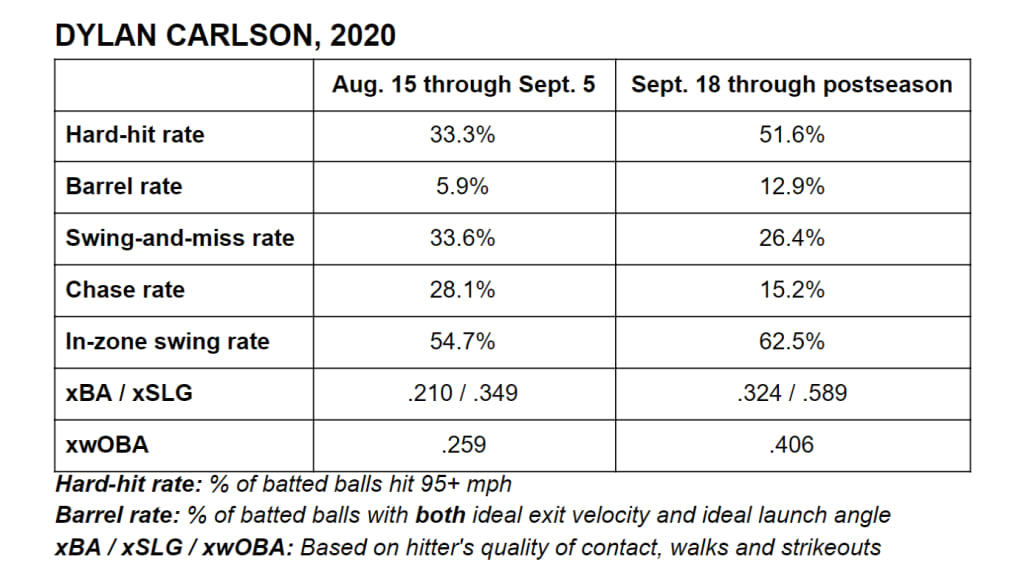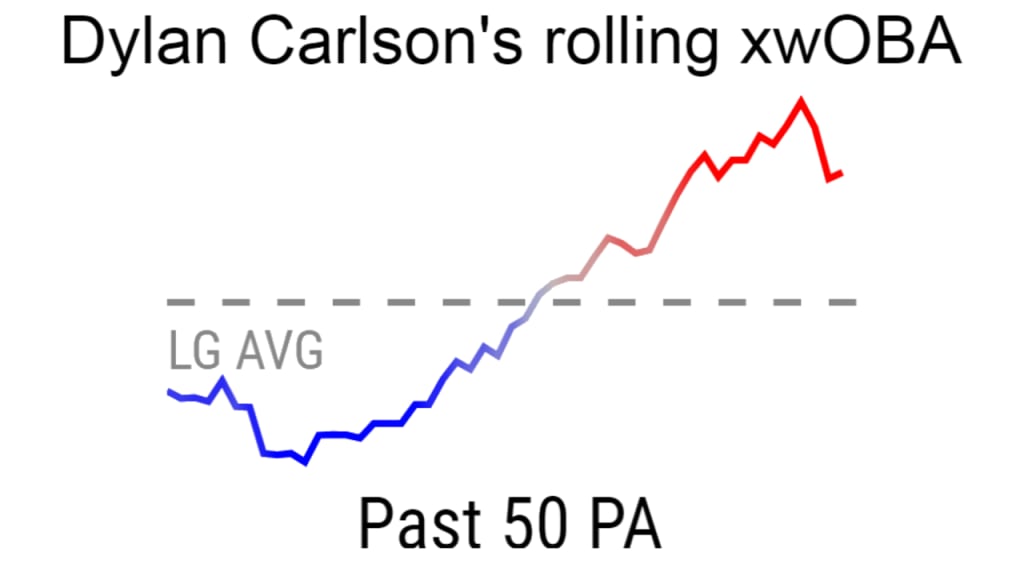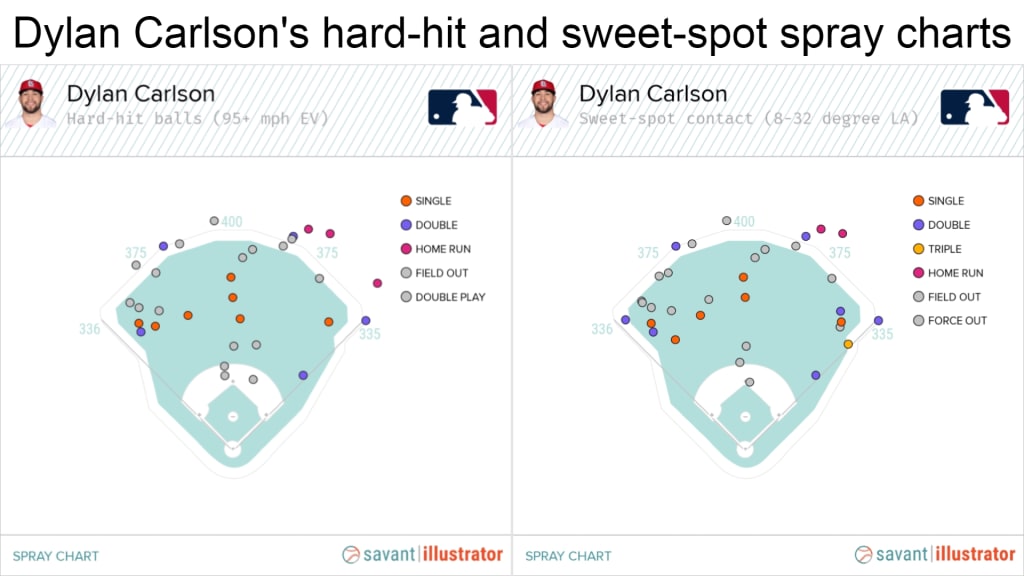The Cardinals need someone to swoop in and help save their offense in 2021. They might already have the player who can do it.
It's Dylan Carlson. St. Louis' No. 1 prospect might have struggled at first when he got called up last year, but if you look a little deeper, you'll see why the 22-year-old switch-hitting outfielder earned his spot as the Cardinals' cleanup hitter during the playoffs -- and why he could be a 2021 National League Rookie of the Year candidate.
For a team that had Paul Goldschmidt and not much else in 2020, and has been fairly quiet on the free-agent front this offseason, Carlson's performance next year could be huge. And we think he's ready for a big role in the Cardinals' lineup.
Here's why Carlson could be the breakout rookie of 2021.
He makes strong contact
There are two main ways hitters can make productive contact -- hitting the ball hard, and hitting the ball at the right angle. That's nothing new, but Statcast can measure it. And Carlson does both.
Statcast classifies both "hard-hit" balls and the launch angle "sweet spot." A hard-hit ball is anything hit 95 mph or harder. That's the exit velocity where hitters really start getting hits. And the sweet spot is a launch angle of 8-32 degrees. That covers both the best "line drive" range for base hits (8-16 degrees) and the best "fly ball" range for extra-base hits and home runs (24-32 degrees). Now, back to Carlson.
Carlson's hard-hit rate and sweet-spot rate in 2020 were both over 40% -- 42.1% of the balls he hit were hard contact, and 40.8% of the balls he hit were in the launch angle sweet spot. Even though he only had 76 batted balls in his debut season, that's still really good. It means he was squaring the ball up. The Major League average hard-hit rate is only 34.9%, and the average sweet-spot rate is 32.8%.
The best part is, Carlson hit the combo of both hard-hit and sweet-spot contact on nearly 30% of the balls he hit. That was top-five in all of MLB for the hitters with at least 75 batted balls last season.
Highest rate of hard-hit + sweet-spot contact in 2020
Of 275 hitters with 75 or more batted balls
- Freddie Freeman (ATL): 33.9%
- Matt Chapman (OAK): 31.5%
- Will Smith (LAD): 30.1%
- Corey Seager (LAD): 29.4%
5-T) Dylan Carlson (STL): 28.9%
5-T) Teoscar Hernández (TOR): 28.9%
Hard-hit: 95+ mph exit velocity. Sweet spot: 8-32 degree launch angle
That is a list of hitters you want to be on -- the hard-hit/sweet-spot leaderboard is filled with MVP candidates and breakout stars of 2020.
Carlson obviously needs to prove he can swing the bat like this over extended big league playing time, and he has some issues to overcome -- strikeouts, for one, and struggles with offspeed stuff in particular -- but the point is that the tools are there, and they show he's a lot closer to a breakout of his own than you'd think just from looking at his 2020 stat line.
He got a lot better down the stretch
Carlson was sent to the Cardinals' alternate site in early September, and the difference when he came back was even bigger than you might have realized.
Carlson from Aug. 15 through Sept. 5 (23 games)
.162 AVG / .215 OBP / .243 SLG / .458 OPS
Carlson from Sept. 18 through the postseason (15 games)
.289 AVG / .389 OBP / .578 SLG / .967 OPS
But it's not just the slash line. Carlson's underlying metrics also improved across the board. He hit the ball harder. He barreled it more. He had better plate discipline -- whiffing less, chasing less and attacking pitches in the strike zone more.
All that goes into Statcast's expected statistics -- expected batting average, expected slugging percentage and the all-encompassing expected wOBA -- which are based on a hitter's quality of contact, plus walks and strikeouts in xwOBA's case. Carlson's expected stats down the stretch were top-tier.

Carlson's rolling xwOBA paints a good picture. It tracks Carlson's quality of contact over every 50-plate appearance span of his season. Over the course of the season, you can see Carlson transform from "poor hitter" to "strong hitter."

All the numbers after Carlson rejoined the Cardinals are great. They're night and day compared to how he started off. And he kept it up through the end of the season and into the playoffs, which is a good sign, too.
He should be a well-rounded player
Carlson has other tools that should help him -- he has good speed, and he hits to all fields.
Carlson was one of the faster players on the Cardinals last season, averaging a sprint speed of 27.9 feet per second. That's about a foot per second faster than the Major League average speed, 27 ft/sec. And he's only 22, so he's not going to lose that speed anytime soon.
He's also not a dead-pull hitter. Carlson actually hit more balls up the middle than he pulled last season -- 35.5% of his contact was pulled, 38.2% was to straightaway center, and 26.3% was to the opposite field. That's a pretty even spray distribution.
If you look at the spray charts of Carlson's hard-hit and sweet-spot contact, they show the same thing. So Carlson was also making good contact to all parts of the field. He did that in the Minors, too, even though most of his home-run power is to the pull side.

Some hitters never see their quality of contact translate to stat-sheet production because they're slow, which costs them hits or extra bases, or because they're too predictable, allowing defensive positioning to take even more hits away. Carlson looks like he has the foundation in place to allay those concerns.
So if we had to guess? This No. 1 prospect is going to play like it in 2021.
